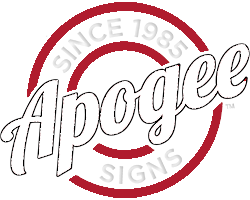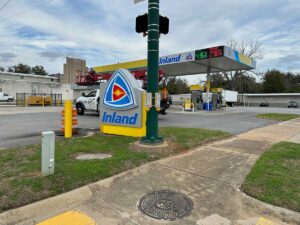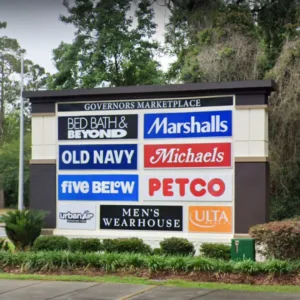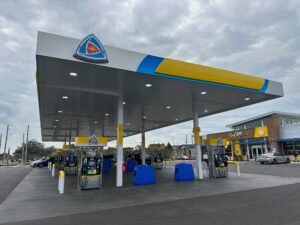
Don’t Let Gas Station Signage Stump You! Get Pumped Up with This FAQ
Is your gas station signage stuck on fumes? Drowning in a sea of regulations and design dilemmas? Fear not, fellow fueler! This comprehensive FAQ is your one-stop shop for navigating the exciting world of gas station signage. We’ll equip you with the knowledge and strategies you need to create signs that not only inform customers but also make your pumps the shining stars that draw them in.
Whether you’re a seasoned station owner looking for a refresh or a new entrepreneur embarking on your gas station journey, this guide will be your roadmap to success. So, grab a cup of joe, settle in, and let’s get started on fueling your business growth with eye-catching, informative signage!
While this FAQ can’t provide state-specific legalities, it can point you in the right direction! Since you operate in both South Georgia and North Florida, you’ll need to check the regulations for both states. Here’s how to find the details:
- South Georgia: Reach out to the Georgia Department of Agriculture (GDA) Fuel and Measures Division. Their website likely has resources or contact information.
- North Florida: Contact the Florida Department of Agriculture and Consumer Services (FDACS) Division of Weights and Measures. Their website should also offer relevant information.
These resources will provide details on legalities like font size, illumination requirements, permitting processes, and any specific wording mandated for your gas station signage.
Update frequency for gas prices depends on local regulations (check with your authorities!).
For corporate chains, digital signage is a game-changer. Update prices remotely from a central location, ensuring consistency across all stations. Some systems even update automatically based on market data, saving time and keeping you competitive.
Local regulations can vary on what additional info you can show alongside gas prices on your signage. Here’s a breakdown:
- Promotions and Offers: In some areas, you might be able to advertise discounts, special offers, or loyalty programs on your gas station signage. This can be a great way to attract customers and boost sales of convenience store items or car washes.
- Branding Elements: Including your gas station’s logo, brand colors, or mascots is usually allowed. This reinforces brand recognition and creates a cohesive visual identity.
- Always Check Locally: The key thing to remember is that regulations can differ by city or county. It’s best to consult your local authorities or industry associations to get clear guidelines on what additional information you can legally display on your gas station signage.
In the fierce competition for motorist attention, crafting gas station signage that pops is crucial. Here’s how to make your pumps the stars of the show:
- Color Psychology: Embrace bold, contrasting colors that stand out from the landscape. Think red, white, and yellow for maximum visibility.
- Clarity is King: Keep your message concise and easy to read from a distance. Use large, clear fonts and avoid cluttering the sign with unnecessary information. Focus on gas prices, your brand logo, and any high-impact promotions.
- Light Up the Night: Ensure your signage is brightly lit, especially for nighttime visibility. Well-lit signs not only attract attention but also enhance security and customer convenience.
- Size Matters (But Not Too Much): A larger sign can grab attention, but be mindful of local regulations. Balance impact with compliance to avoid attracting unwanted penalties.
- Embrace the Digital Age: Digital signage lets you display dynamic content, eye-catching animations, and even short advertisements. This technology allows for instant price updates, increased flexibility, and a more modern, engaging customer experience.
- Think Outside the Box: Consider incorporating unique design elements into your signage. A well-designed canopy, interesting architectural features, or even creative landscaping can set you apart from the competition.
By implementing these strategies, you can transform your gas station signage from an afterthought into a powerful marketing tool that attracts customers and keeps them coming back for more.
Digital vs. Static Signs: Choosing the Perfect Display
The battle rages on: digital signs or static signs? Both have their pros and cons, so the best choice depends on your specific needs and budget.
-
Digital Signs: Shine bright with:
- Quick and Easy Updates: Change prices in seconds from anywhere with an internet connection. No more scrambling to climb ladders!
- Versatility Extraordinaire: Showcase not just prices, but also promotions, product availability, or attention-grabbing greetings.
- Eye-Catching Brilliance: Digital signs are generally brighter and more vivid, especially at night, making them hard to miss.
-
Static Signs: Hold their ground with:
- Budget-Friendly: The upfront cost is significantly lower than digital signs.
- Simpler Upkeep: Generally require less maintenance than digital displays.
So, which one is right for you?
Consider these factors:
- Budget: If upfront cost is a major concern, static signs might be the way to go.
- Update Frequency: If gas prices fluctuate often in your area, the speed and ease of digital updates become highly valuable.
- Visibility Needs: For maximum impact, especially in low-light conditions, digital signs win the visibility war.
The Verdict?
Digital signs offer a modern, flexible approach, ideal for stations that prioritize quick updates, displaying additional information, and standing out from the competition. Static signs remain a cost-effective option for stations with less frequent price changes and a focus on keeping initial costs down.
Your gas station signage can be a silent salesperson, promoting not just your gas prices but also the wealth of products and services you offer inside. Here’s how to leverage your signage for maximum impact:
-
Secondary Static Signs: These smaller signs, often positioned below the main gas price display, are prime real estate for highlighting specific convenience store items. Think fresh coffee, hot food deals, or popular snacks. You can even use them to advertise car washes, ATM availability, or loyalty programs.
-
Digital Signage Magic: If you’ve opted for digital gas price signs, you’ve unlocked a treasure trove of promotional possibilities. Create eye-catching rotating messages showcasing your deli specials, discounted car washes, or loyalty program benefits. Digital signs allow you to schedule promotions strategically, targeting peak traffic hours or specific days of the week.
-
Combo Approach: Don’t be afraid to combine static and digital signage. Utilize static signs for core offerings like car washes or ATMs, while reserving digital displays for limited-time promotions or new product launches. This layered approach ensures essential information is always present, while maintaining the flexibility to keep customers engaged with exciting new offers.
By strategically using signage, you can transform your gas station from a simple fuel stop into a one-stop shop for convenient essentials and attractive services.
In today’s competitive gas station landscape, digital signage can be a powerful tool to attract and retain customers. Here’s how:
-
Effortless Price Updates: Ditch the ladder and manual sign changes! Digital signs allow for instant price updates from any location with an internet connection. This ensures your prices are always accurate and competitive, even during volatile market fluctuations.
-
Beyond Just Prices: Digital signs are more than just glorified price tags. They offer a dynamic platform to showcase promotions, advertise convenience store items or car washes, and even greet customers with personalized messages. This versatility allows you to upsell and promote additional revenue streams within your station.
-
Enhanced Customer Experience: Digital signs can create a more visually engaging experience for customers. Eye-catching animations, bright displays, and the ability to showcase product information can make waiting at the pump more tolerable, potentially leading to increased in-store purchases.
Digital signage goes beyond mere functionality; it elevates your gas station’s image and allows you to better connect with your customers.
Estimating the exact cost of your gas station signage upfront can be tricky, as several factors come into play. Here’s a breakdown to help you navigate the pricing landscape:
- Size is a Big Deal: Naturally, bigger signs cost more. A towering pylon sign with multiple price displays will set you back more than a basic pump topper sign.
- Complexity Can Add Up: Simple signs with standard fonts and minimal lighting are more affordable than those with intricate designs, custom lettering, or elaborate illumination features.
- Material Matters: Digital LED signs generally have a higher upfront cost than static aluminum signs. However, digital signs can make up for the cost difference in the long run with their lower maintenance needs.
- Static vs. Digital: As mentioned earlier, digital signage offers greater flexibility and visibility, but comes with a steeper price tag initially. Static signs are a more budget-friendly option, but require manual price updates and may not be as eye-catching.
Ultimately, the best way to get a precise quote is to consult with signage companies. Provide them with details like the desired size, complexity, and material preference (digital or static). With this information, they can provide a tailored estimate that reflects your specific needs and budget.
When it comes to ongoing maintenance costs, digital and static signage diverge. Here’s a breakdown:
-
Static Signs: Generally require less maintenance than their digital counterparts. The main cost might be replacing burned-out bulbs in illuminated signs. Periodic cleaning to remove dust, grime, or debris might also be necessary to maintain visibility. However, these needs are infrequent and relatively inexpensive to address.
-
Digital Signs: While boasting a higher upfront cost, digital signs often see lower ongoing maintenance expenses. They typically use energy-efficient LED displays, reducing the frequency of bulb replacements needed with static signs. However, digital signs rely on software and hardware that may require occasional updates or repairs. The cost of these can vary depending on the complexity of the system and any service contracts you have in place.
Ultimately, the ongoing maintenance costs tend to even out over time. While static signs require less frequent attention, the need for bulb replacements can add up. Digital signs might require more specialized maintenance, but the overall cost might be comparable due to their energy efficiency and potentially less frequent interventions.
Conquering the elements is key for your gas station signage. Here’s how to ensure it thrives in any weather:
- Material Matters: The right material makes all the difference. For digital signs, opt for LED displays with weatherproof casings. Static signs should have metal frames, known for their durability against harsh conditions. Aluminum is a popular choice for its strength and resistance to rust.
- Weatherproofing Wisely: Don’t underestimate the power of a good sealant. Apply a coat of weatherproof sealant on exposed wooden elements of static signs for additional protection against rain and moisture.
- Installation Ingenuity: Proper installation is crucial. Ensure your signs are securely mounted using appropriate brackets and fasteners suitable for the chosen material and local wind conditions. This minimizes the risk of damage from strong gusts or heavy winds.
By following these tips, your gas station signage will stand strong against the elements, ensuring clear communication and lasting value for your business.
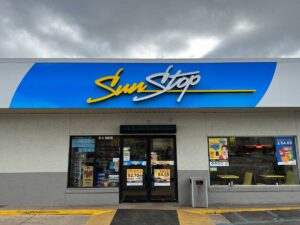 This FAQ has hopefully empowered you to navigate the exciting world of gas station signage with confidence! Remember, clear, informative, and eye-catching signage is a silent salesperson, working 24/7 to attract customers and fuel your business’s success. By understanding legal requirements and permitting processes, exploring design options that inform and entice, and choosing the right signage type for your budget and goals, you can create a lasting positive impression.
This FAQ has hopefully empowered you to navigate the exciting world of gas station signage with confidence! Remember, clear, informative, and eye-catching signage is a silent salesperson, working 24/7 to attract customers and fuel your business’s success. By understanding legal requirements and permitting processes, exploring design options that inform and entice, and choosing the right signage type for your budget and goals, you can create a lasting positive impression.
Whether you opt for the dynamic flexibility of digital signs, allowing for instant price updates and promotional messages, or the cost-effective simplicity of static signs, ensure they comply with regulations and weather any storm. With the right approach, your gas station signage will transform from a simple necessity into a powerful marketing tool, continuously guiding drivers in, keeping your business relevant, and fueling your bottom line. So, put these insights into action and watch your pumps become beacons that draw customers in, keeping your station top-of-mind and your business thriving!
